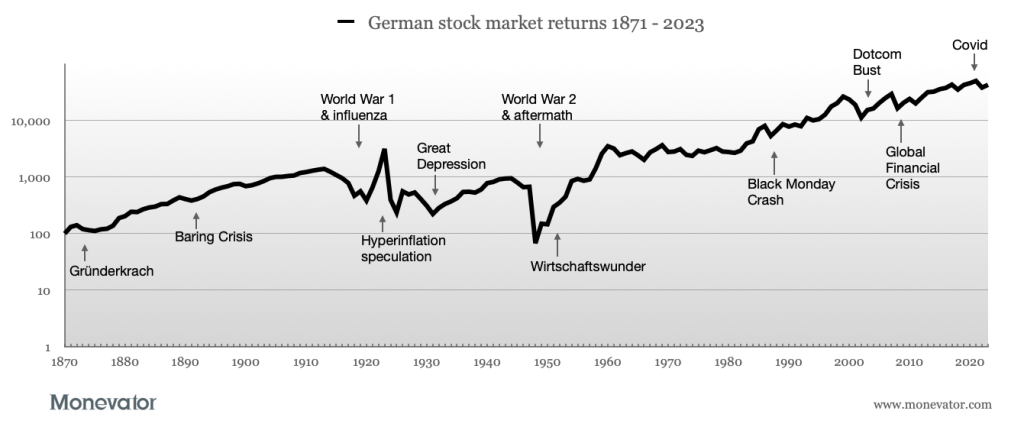
After a gruelling year in which bonds got pasted, it’s time to take a hard look at the other defensive assets that can comprise a truly diversified portfolio. Bonds alone are not enough.
We Brits imported the idea that government bonds can shoulder the burden of defensive duties alone from the US. But their perspective is misleading, because their bonds have performed much better than ours:
Data from JST Macrohistory 1 and Aswath Damodaran. January 2022.
The chart shows annual real returns2 of US equities against US government bonds over the past 123 years.
When the blue equity bars head south, we want the orange bond bars to point north.
In a nutshell, the case for US government bonds is pretty sound:
US Treasuries are often negatively correlated3 with US equities in a crisis. (They tend to rise when equities fall).
US bond losses have been quite merciful. Up until 2022, that is!
For a defensive asset US bonds have done pretty well: 1.44% annualised from 1900 through 2022.
(All returns quoted in this piece are inflation-adjusted real returns.)
The track record of UK gilts is less impressive:
Data from JST Macrohistory and FTSE Russell.
As an aside, as a proud citizen of Blighty I can’t help but notice how the thick-wooded mass of positive US equity returns in the first graph contrasts with the stunted scrub-land of their UK counterparts in the second. It’s a reminder of why we need to be globally diversified.
The really unflattering comparison though is with our government bonds.
Bungling bonds
The UK experience is that our gilts relatively rarely put in a positive performance when equities are down.
In fact, the rise of gilts when equities tumble is mostly a 21st Century phenomenon.
Gilts are more temperamental than their US cousins. They’ve meted out bear market losses five times and breached -30% losses twice.
To top it off, their long-term growth contribution is a measly 0.91% annualised return.
UK government bonds have been less effective than US Treasuries in large part because we’re more vulnerable to inflation over here.
Why a diversified portfolio needs a multi-layered defence
Bonds hate accelerating inflation. So we need to layer in additional diversifying investments, which aren’t as susceptible to the inflationary money bandit.
Click to enlarge. Gold GBP data from The London Bullion Market Association and Measuring Worth. Cash data from JST Macrohistory and JP Morgan Asset Management. January 2022.
This chart shows how several key diversifying asset classes perform when we narrow the focus to years when equities posted a negative annual return.
Exciting technical note: In this chart I’ve used the performance of UK Treasury Bills as a proxy for cash. Ordinary investors can hope to do better with ‘best buy’ savings accounts. Gold returns are priced in pounds.
UK equities ended the year down 42 times out of 123 from 1900-2022. That’s 34% of all occasions. Ideally we’re looking for defensive assets that pop their heads over the 0% parapet whenever the going gets rough with shares.
We can see cash offers some limited resistance at times. Gold wins a medal for defying the big, bad bears of the 1970s and the Global Financial Crisis.
But not a single asset class relieves the pain with convincing regularity – not across the entire timeframe.
There are also wasted years when nothing works.
This muddy picture suggests we need a bit of everything.
How often defensive assets support a diversified portfolio
The bar chart shows how often each asset class succeeded in diversifying against equity losses. By which I mean they weren’t as bad as equities that year. It doesn’t mean they always clocked up a positive return.
Gilts softened the hard equity rain in just under 70% of all stock market down years. Gold rode to the rescue almost 80% of the time. Meanwhile cash deployed its emergency parachute on 86% of occasions.
On the other hand, each diversifier sometimes made matters worse:
Gilts 31% of the time
Gold 21% of the time
Cash 14% of the time
Remember we’re talking inflation-adjusted returns here, which explains why cash can be a loser even when shares are down.
Nobody’s perfect
I don’t think the fallibility of portfolio diversifiers is widely understood. Many investors expect their portfolio countermeasures to work perfectly every time. They don’t.
In fact, all three diversifiers failed simultaneously 10% of the time. That means equities were actually the least-worst asset class to own during those particular down years.
Oh, you were hoping your defensive assets would actually produce a positive return during a crisis were you?
Tsk! Some people.
Okay, just for you let’s see how often the diversifiers landed sunny-side up.
Frequency that diversifying asset classes produce positive returns
Hmm, not great.
Gilts coughed up a positive result barely 29% of the time. Gold scrapes over the 40% line and cash manages a 42% hit rate.
And all three turned negative simultaneously in 36% of years that equities fell.
Psychologically that’s going to grind down anyone if they don’t realise it’s perfectly normal!
Portfolio diversification isn’t broken. This happens sometimes. More often than we’d like to think.
Although it’s easier to live with if we remind ourselves that storms pass and the long-term outlook is highly favourable.
What is the best diversifying asset class when equities fall?
Which asset class generates the strongest performance during a down year?
Cash dominates the field, then gold. Gilts head up the defence only 17% of the time.
Again, that blue wedge shows that the diversifiers fell further than equities four years out of 42.
(Note: The pie doesn’t sum to 100% due to rounding errors and The Investor’s allergy to decimal points.)
But not all stock market slumps are equally terrifying. How do the diversifiers offset the risks of equities during the biggest disasters faced by UK investors?
Defensive diversifiers vs the UK’s eight worst bear markets
Our historical record contains some dark days. The all-time low occurred when the stock market collapsed -72% in 1972-74.
Meanwhile, World War One and the Spanish Flu combined to smash stocks -57% from 1913 to 1920.
World War Two was the awful sandwich between two bears. The first letting rip in the late 1930s, with the second only subsiding by 1952.
Here’s how often each asset class blunted the UK stock market’s eight biggest blows:
Asset
Outperformed equities
Positive return
Best diversifier
Failed
Gilts
6
3
1
2
Gold
8
4
4
0
Cash
7
4
3
1
By this measure gold and cash still look like the UK’s leading emergency first responders.
Gold beats equities in all eight nightmare scenarios. It delivers a positive return four times, and was the best diversifier four times. Cash notches similar numbers.
That’s especially worth noting if you’re a retiree whose sustainable withdrawal rate depends on your portfolio surviving an investing tsunami of a similar magnitude.
If you combine the three defensives into a single diversified portfolio then:
All assets outperformed equities six times out of eight. All assets were in negative territory on three occasions. At least one asset managed a positive return five times.
There wasn’t a single calamity when all three assets failed to improve portfolio returns.
Horses (of the Apocalypse) for courses
World War One and its aftermath was terrible across the board. Cash was the top-performing asset on this occasion. But it was still down a cumulative 45% by New Year’s Eve 1920.
The Great Depression wasn’t as big a shock to the UK system as it was to America’s. Our equities were down -29%. But gilts and cash both rose by over 20%, with gold not far behind.
Also note that:
The diversifiers all have a pretty good record against deflation. Especially gilts.
Everything fell into the red during World War Two and stayed there.
Gilts really benefit from negative correlations with equities from the Dotcom Bust on… until 2022.
The connection here is interest rates. Gilts are likely to perform in a crisis when interest rates are cut rapidly to deal with falling demand. But gilts are typically a loser when interest rates rapidly rise – especially when inflation rears its ugly head. (Hello 2022!)
Gold also has a solid track record during 21st Century slumps. Partly thanks to the role of the dollar as a safe haven.
King dollar to the rescue
Sterling generally weakens like a balding Samson during ‘risk-on’ events. Which means that UK investors who own USD-priced assets – including gold – will often experience a welcome ‘bounce’ in that corner of their portfolios when the dollar appreciates.
If you’re intrigued but not convinced enough to hold unhedged US Treasuries in your diversified portfolio, then gold is another way to benefit from that currency shift during a market storm.
Would you like to play a game of Risk?
Inflation, pandemics, and war are the major threats that are hard to adequately defend against.
The years when all three diversifiers turn simultaneously negative occur around World War One, World War Two, the Suez Crisis, and the Covid/Ukraine polycrisis.
Government bonds were useless in four out of five of those onslaughts. But you wouldn’t have wanted to be without them in the Great Depression, the Dotcom Bust, or the Global Financial Crisis.
A realistic reading of history admits the scale of those events is not predictable.
Remember that a number of smoking crises had already been snuffed out before Europe combusted into World War One. Even then the major players thought the war would be short.
The Great Depression was preceded by the euphoria of the Roaring Twenties.
Hitler could have been stopped earlier.
The world was unprepared for Covid. And Putin’s Ukraine atrocity, too.
I could go on.
The point is we don’t know what will happen. So why not lean into diversification and spread your bets across every useful defensive asset class?
Isn’t there anything better to diversify risk?
Property REITs, private equity, infrastructure, dividend stocks, and other equity sub-asset classes are all highly-correlated when there’s a global FUBAR.
So I say: “Next!”
Index-linked bonds and broad commodities are the two obvious next stops. But our short-term index-linked bond fund pick was beaten by gold and cash in 2022. That’s despite its supposed role as an inflation hedge.
The short answer to that conundrum is that index-linkers can provide good protection against prolonged, unexpected inflation – provided you buy individual index-linked gilts for a reasonable price, and hold them to maturity.
The even shorter answer is it’s complicated. Especially with index-linked gilt funds.
Non-retirees may well be better off relying on equities to simply outpace inflation over time.
Broad commodities are a wild card. They’re occasionally awesome as in 2022 and 1973-74. But more often they’ll drag you down like concrete Ugg boots.
Moreover, commodities’ long-term returns look like chump change. Which brings us to another important point.
Diversifiers must be growth-positive
Why not just ditch government bonds? Here’s one reason: gilts’ long-term growth rate is better than gold or cash.
The 1900 to 2022 scores on the doors are:
Equities: 4.85% Gilts: 0.91% Gold: 0.82%Cash: 0.45%
Gilts are twice as good as cash, as measured by UK Treasury bills. It’ll be a closer run thing with best buy cash accounts. But the point still stands.
The expected returns of government bonds are higher than gold and cash.
Diversifying risks in a down market
Doubtless we can dial up an optimal blend of assets based on historical returns to reassure ourselves we have the best diversified portfolio possible.
But the truth is there’s no point in finessing asset allocation to the last percentile when past is not prologue.
What the UK’s historical asset class returns tell me is we need them all – because we need to be ready for anything.
For portfolio equity allocations of 60% and above, I’d personally take the defensive remainder and split it evenly three ways between government bonds, gold, and cash.
Or four ways if you are keeping the faith with index-linked bonds. (I am.)
This is a rough-and-ready solution but that’s fine because ‘Man plans and God laughs’.
Apologies to all the non-men out there but it’s a good adage.
Take it steady,
The Accumulator
Postscripts
P.S. If I was starting my diversified portfolio from scratch, I’d invest in global government bonds hedged to GBP rather than just gilts. Here’s some ideas for the best bond funds.
P.P.S. You may conclude that you should just invest in US securities and be done with it. But there’s no guarantee that America’s charmed run will continue. Not because its superpower status is imperilled but because US returns have lagged the rest of the world for entire decades in the past. Ultimately, equity results rest upon valuations. If the prices of US securities are bid too high then they will disappoint those who buy based purely on recent performance. Stay global!
P.P.P.S. I examined UK returns going back to 1871, but equities were only down one year in the Victorian Golden Age. Our top-hatted forebears had to cope with a -1.1% thrashing in 1891, triggered by the Baring Crisis. Gilts and cash were both marginally positive that year, with treasury bills just edging it.
P.P.P.P.S. This is getting silly now.
Òscar Jordà, Katharina Knoll, Dmitry Kuvshinov, Moritz Schularick, and Alan M. Taylor. 2019. “The Rate of Return on Everything, 1870–2015.” Quarterly Journal of Economics, 134(3), 1225-1298.Real returns subtract inflation from your investment results. In other words, they’re a more accurate portrayal of your capital growth in relation to purchasing power than standard nominal returns.A positive correlation of 1 indicates two assets move up or down together in perfect sync. A negative correlation of -1 indicates they move in opposite directions: when one rises, the other falls. We want diversifying assets to be negatively correlated with equities when stock markets slump. Although we don’t want them to nose-dive when equities rise, either, so ironically it’s best that two assets aren’t perfectly negatively correlated. A correlation of 0 shows that two assets are randomly correlated. In other words, their movements have no relation to each other.
The post Why a diversified portfolio needs more than just bonds appeared first on Monevator.



